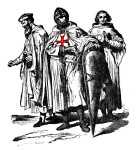Where was the Shroud from 1204 to 1357?
We know that the crusaders of the Fourth Crusade looted the treasures of Constantinople and carried away many riches and relics. The Edessa Cloth disappeared with other priceless treasures. Evidence suggests that the Edessa Cloth was taken to Athens. About a year after Constantinople was plundered, Theodore Ducas Anglelos wrote in a letter to Pope Innocent III:
The Venetians partitioned the treasure of gold, silver and ivory, while the French did the same with the relics of saints and the most sacred of all, the linen in which our Lord Jesus Christ was wrapped after His death and before the Resurrection. We know that the sacred objects are preserved by their predators in Venice and France and in other places, the sacred linen in Athens.
In 1207, Nicholas d'Orrante, Abbott of Casole and the Papal Legate in Athens, wrote about relics taken from Constantinople by French knights. Referring specifically to burial cloths, he mentions seeing them "with our own eyes" in Athens.
 There
is some indication that the Shroud may have passed into the hands of an
order of warrior monks known as the Knights Templar. This order was founded
in the early 12th century among Crusaders in the Holy Land.
There
is some indication that the Shroud may have passed into the hands of an
order of warrior monks known as the Knights Templar. This order was founded
in the early 12th century among Crusaders in the Holy Land.
Ian Wilson and John C. Iannone relate stories that link the Edessa Cloth to the Marquis Boniface de Montferrat who led the attack on the Bucholean Palace and Pharos Chapel in Constantinople where the cloth was kept; how when it appeared in Athens it was in the trust of Otto de la Roche, an associate of Boniface; and how it may have passed into the hands to the Knights Templar from there. They go on to relate how the knights were later accused of secret idol worship of a "bearded head." We know, also, that the Templars had amassed a significant cache of relics from the Crusades.
| In 1945, at a Knights Templar site in Templecombe, England, a panel of wood was found above a plastered ceiling that contained a painted image of Jesus' head that closely resembles the face on the Shroud. Ian Wilson tells us that carbon 14 dating of the wood panel dates the panel to as early as 1280 CE. |
The Shroud's history suffers from gaps in documentation. This is true of almost all ancient artifact. There are plausible reasons why the Shroud may have been concealed from public knowledge. In Jerusalem, it would likely have been sought out and destroyed by the Temple authority had its very existence been known. While that is conjecture, it is nonetheless a possible explanation why no early mention is made of it.
During the many persecutions of the first three centuries valuable relics, writings and ceremonial items of the church were routinely destroyed. We know of early persecutions of Jesus' post-crucifixion followers in Jerusalem. There is evidence of persecutions in Edessa as early as the latter part of the first century. And there were the numerous Roman persecutions that persisted until Constantine. If, in fact, the Shroud was taken to Abgar V of Edessa, it might have been hidden in the city walls as early as the reign of Ma'nu VI who is thought to have reverted to paganism.
If the Templars obtained the Edessa Cloth in Constantinople, in Athens, or later, it is perfectly reasonable to think that they might have concealed it. We know that they were a powerful, rich and secretive organization. Under Phillip IV of France, efforts to suppress their power and acquire their assets resulted in extraordinary charges being leveled against them, including secret rituals of worshipping an image with a bearded man's face. In 1307, the leaders of the Templars, were executed. One of the leaders was a knight called Geoffrey de Charny, possibly a relative of the Geoffrey de Charny who displayed the Shroud in Lirey in 1357 and was reluctant to explain where it came from